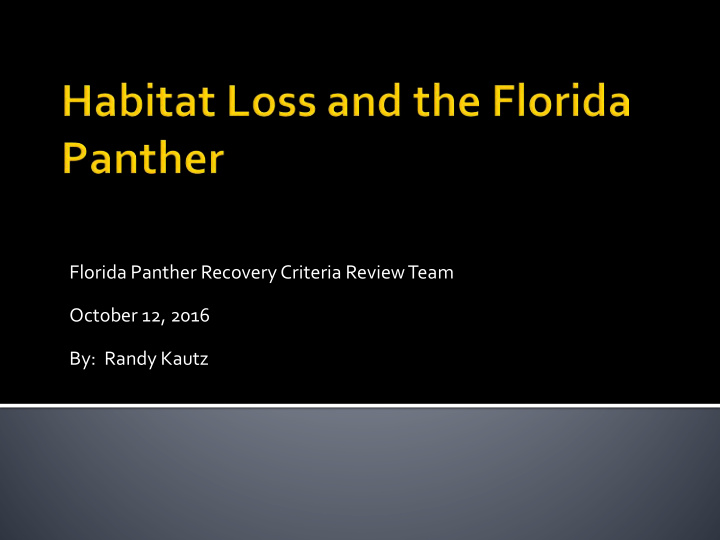



Florida Panther Recovery Criteria Review Team October 12, 2016 By: Randy Kautz
Florida and South Florida: 1936-1987 Statewide Change Detection: 1987-2003 SFWMD Land Use/Land Cover: 1995-2008 Cooperative Land Cover Data: 2003-2015 Future Habitat Loss: Next 10-50 Years
• 4.3 million acres lost • 21% decline over 51 years • 0.41% loss/year Source: Kautz, R. 1993. Trends in Florida wildlife habitat 1936-1987. Florida Scientist 56(1):7-22. (Based on an analysis of USFS Forest Inventory Assessment data).
Ten Counties : Charlotte, Glades, Lee, Hendry, Collier, Martin, Palm Beach, Broward, 0.65% loss/year Miami-Dade, Monroe Source: Kautz, R. 1994. Historical trends within the range of the Florida panther. Pages 285-296 in Jordan, D. B., editor. Proceedings of the Florida panther conference. Florida Panther Society, Inc.
1986/1988 2003 Source: Kautz, R., B. Stys, R. Kawula. 2007. Florida vegetation 2003 and land use change between 1985-89 and 2003. Florida Scientist 70(1):12-23.
Natural Cover Types : Conversion Classes : Pinelands Natural to Agriculture Forested Wetlands Upland Hardwoods Natural to Dry Prairie Urban/Developed Shrub and Brushland Shrub Swamp Agriculture to Freshwater Marsh and Wet Urban/Developed Prairie Scrub Natural to Water Coastal Salt Marsh Mangroves
Change Type Acres Primary Zone 1986/88-2003 Natural to Agriculture 55,883 Natural to Developed 3,952 Agriculture to Developed 11,745 Natural to Water 30,744 Total Change 102,324 Loss of Natural Habitat 90,579 0.28% loss of natural habitats per year
South Florida Water Management District Land Use/Land Cover Data: 1995 and 2008 Methods: FLUCCFS codes for each date reclassified to USFWS panther cover types Panther scores applied to cover types Each date clipped to Primary Zone and Adult Breeding Habitat (Frakes et al. 2015) Gains and losses in acreages compared Changes in PHUs compared to assess habitat degradation Source: Randy Kautz, unpublished data
1995 Panther Primary Zone 2008 Reclassification of Forest to Marsh
1995 Adult Breeding Habitat (Frakes et al. 2015) 2008 Reclassification of Forest to Marsh
Florida Panther Primary Zone (0.26% loss of natural habitat/year) Onorato et al (2011) 1995 2008 Difference % Change/Year Major Cover Types Acres PHU Acres PHU Acres PHU Acres PHU Upland Forest 160,984 1,518,984 202,070 1,897,652 41,086 378,669 1.96 1.92 Wetland Forest 738,416 6,793,427 474,874 4,368,839 -263,542 -2,424,588 -2.75 -2.75 Prairie Grassland 133,539 730,814 147,928 824,285 14,389 93,470 0.83 0.98 Marsh-Shrub-Swamp 1,057,145 5,074,288 1,300,029 6,365,500 242,884 1,291,212 1.77 1.96 Agricultural 92,757 442,296 72,287 344,228 -20,470 -98,068 -1.70 -1.71 Other 87,575 207,245 73,229 144,322 -14,346 -62,923 -1.26 -2.34 Total 2,270,416 14,767,054 2,270,417 13,944,826 - - - - Adult Breeding Habitat (Frakes et al. 2015) (0.11% loss of natural habitat/year) Onorato et al (2011) 1995 2008 Difference % Change/Year Major Cover Types Acres PHU Acres PHU Acres PHU Acres PHU Upland Forest 145,758 1,375,153 187,518 1,761,724 41,759 386,571 2.20 2.16 Wetland Forest 656,079 6,035,928 449,101 4,131,729 -206,978 -1,904,199 -2.43 -2.43 Prairie Grassland 102,004 562,980 109,396 610,158 7,392 47,179 0.56 0.64 Marsh-Shrub-Swamp 376,794 1,832,553 556,361 2,805,305 179,567 972,751 3.67 4.08 Agricultural 58,582 278,941 48,636 231,372 -9,945 -47,569 -1.31 -1.31 Other 39,239 85,853 27,464 49,965 -11,775 -35,888 -2.31 -3.22 Total 1,378,456 10,171,408 1,378,476 9,590,254
Analyses by Dr. Robert Kawula (FWC) Presented to Panther Recovery Implementation Team Meeting April 2016 Compares FWC 2003 Land Cover Data with Cooperative Land Cover Data for 2015 Primary, Secondary, and Dispersal Zones
Panther Habitat Reclassification FWC 2003 CLC
Habitat Change (2003-2015) Natural Habitat → Agriculture (non-pasture) Natural Habitat → Urban/Developed Natural Habitat → Other Non-habitat
Difference between 2003 and current CLC 2015 (ac) Habitat Type Primary Secondary Dispersal Total difference Upland Forest -23372 -12480 -526 -36377 Wetland Forest -136677 -3433 594 -139517 Open grassland/pasture 1737 -25331 306 -23288 Marsh/shrub/scrub 130613 3333 -215 133731 Agriculture 288 297 -256 330 Urban/developed 15035 31953 -773 46215 Other 12376 5661 -182 17855 Primary Zone: 0.06% loss of natural habitat/year Primary, Secondary, and Dispersal Zones: 0.15% loss of natural habitat/year
Proposed Developments on the Books Developments of Regional Impact (DRI) Planned Unit Developments (PUD) Sector Plans Habitat Conservation Plan (East Collier RLSA) Methods Union development shape files with PFA Calculate area lost to future development by zone Estimate panther impacts using density estimates Randy Kautz, unpublished data
Estimates of Florida Panther Density Panther Density Sources Ha Acres Maehr et al (1991) 11,000 27,181 Sollmann et al (2013) 6,135 15,160 Sollmann et al (2013) 6,024 14,866 Panther Habitat Lost to Development and Estimated Impact on Population Panthers Lost to Estimated Total Proposed Development Development* Population* % Zone Acres Acres % of Zone No. No. Loss Primary Zone 2,270,417 69,872 3.1 4.7 153 3.1 Secondary Zone 812,045 99,725 12.3 6.7 6 - Dispersal Zone 27,879 2,630 9.4 0.2 0.2 - *Estimated based on panther density of one panther per 14,866 acres (Sollmann et al. 2013)
Habitat Has Been and Continues to Be Lost 1936-1987 (USFS Data) ▪ Florida: 4.3 M acres of forest lost (21% decline; 0.41%/year) ▪ South Florida: 0.98 M acres lost (33% decline; 0.65%/year) 1987-2015 (FWC and SFWMD Data) ▪ ~118,300 acres of natural habitat converted to agriculture or urban in Primary Zone (0.11%-0.28% loss of natural habitats/year) ▪ Most areas converted to agriculture, not urban development ▪ Classification problems: wetland forest in older data sets classified as herbaceous wetlands suggest greater loss of forest cover than actually occurred Future Loss of Habitat Developments currently on the books could result in the loss of 172,200 acres of Primary, Secondary, and Dispersal Zone habitat That loss habitat could reduce the carrying capacity of the Primary Zone by as many as 4-5 panthers Equivalent of 3% of Primary Zone population
Recommend
More recommend